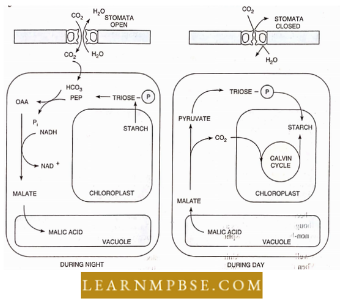NEET Biology Photosynthesis And Translocation Of Organic Solutes
The food is manufactured by green parts of the plants by the process of photosynthesis. In the presence of sunlight. CO2 and water, green parts synthesize carbohydrates and liberate O2.
- The pigments needed are chlorophyll, carotenes, xanthophylls and phycobilins. The cells have chloroplasts which are semi-autonomous cell organelles, double membranous structures with matrix, and stroma. DNA. RNA, grana etc.
- The mechanism involves light and dark reactions. The light reaction needs light in which there is photolysis of water, photophosphorylation, formation of assimilatory power (NADPH, and ATP) and O2 is released. Phosphorylation may be cyclic or non-cyclic.
- The dark reaction, as the name indicates, does not require light but continues even in the presence of light. Various reactions are in the form of a cycle called the Calvin cycle.
- Ribulose 1,5 diphosphate is the initial acceptor of CO–, to produce phosphoglyceric acid (3-carbon compound). It utilises assimilatory power (NADPH2, ATP) to produce 3 phosphoglyceraldehyde.
- A part of it is converted into carbohydrates while the remaining part is converted in a series of reactions into Ribulose 1,5 diphosphate. So there is cyclic production and utilization of this compound. On one side CO2, ATP and NADPH2 are used while on the other side, carbohydrates are produced.
- Plants showing the above mechanism are called C3 plants as the first stable product is 3- phospho-glyceraldehyde. In C4 plants, the first stable product is oxaloacetic acid. Important Events in the Discovery of Photosynthesis
Read and Learn More NEET Biology Notes
NEET Biology Photosynthesis And Translocation Of Organic Solutes Important Events In The Discovery Of Photosynthesis
- Aristotle and Theophrastus (370 B.C.) believed that plants get their food supply from organic matter in the soil by absorption.
- Ancient Indians believed that plants feed from their feet.
- Van Helmont (1648). He experimented with a small willow twig and concluded that “All vegetation is only water.”
- Woodward (1699) concluded by his experiments that when water is absorbed from the soil, certain material for growth is also made available to the plant.
- Stephen Hales (1727) often known as the ‘Father of Plant Physiology’ was the first to say that leaves to manufacture the food and light may play some role in manufacturing the food.
- Priestley (1722) gave the elementary idea of gaseous exchange, due to which the atmosphere remains pure. He concluded that vegetation purifies the air.
- Ingenhousz (1779) propounded the view that light and chlorophyll play a definite role in photosynthesis. He gave the following reaction for photosynthesis.
Plants - Lavoisier (1783) identified the purifying principle produced by green plants in sunlight as oxygen and the noxious air produced by the burning of candles as CO2 (phlogiston).
- Senebier (1782) gave the idea that as the concentration of CO2 is increased, the rate of evolution of O2 also increases.
- Jean Senebier (1800) said that O2 is released from CO2 from green plants. He further said that red light of the visible spectrum is the best light for the process of photosynthesis.
- Dutrochet (1837) confirmed by his experiments that chlorophyll is necessary for the process of photosynthesis.
- De Saussure (I804) gave the following additions:
- Importance of water in the process.
- CO2 is absorbed by plants instead of carbonic acid.
- Another significant breakthrough was the discovery of the fact that CO7 absorbed is equal to oxygen released.
- Von Mayer (1845) gave the following equation :
- CO2 + H2O + light energy Green Plants ^ Organic matter + chemical energy + O2
- Lcibig 0845) pointed out that organic matter was derived from CO, and water was used in the photosynthesis.
- Sachs et al 0 887) concluded that chloroplasts use CO2 to release O2 He found starch as the first visible food.
- Engelmann 0888) plotted the action spectrum of photosynthesis.
- Blackman 0905) introduced Blackman’s law of limiting factor.
- Warburg 0 920) introduced the unicellular green alga chlorella as a suitable material to study photosynthesis.
- Van Neil 0930) established the foundation of a new era for solving the mystery of photosynthesis by concluding that 02 is released from H,0 and not from CO2
- Robin Hill 0939) demonstrated that separate light reactions were present in a chloroplast.
- Ruben and Kamen 0941) used radioactive O18 to confirm that O2 released is produced from H,O2
- Amon (1954) found that light and dark reactions are separable.
- Emerson (1957) showed a red drop and the Emerson effect.
- Amon (1967) proposed a scheme for the existence of two photosystems in the light phase.
- Hatch and Slack (1965) formulated the Hatch and Slack cycle of C4 plants for fixation of CO2.
- Rouhani et al, (1973) introduced the CAM pathways in the Sedum plants.
- Huber, Michael and Dissenhofer (1985) crystallized the photosynthetic centre of the bacterium Rhodobacter and analysed its structure by X-ray Diffraction technique. They were awarded the Nobel Prize in Chemistry (1988).
- Peftilier and Caventon (1818) coined the term chlorophyll.
- G.G. Stokes was the first to separate pure fractions of chlorophyll-u and chlorophyll-b
- Willstatter and Stoll (1913) were the pioneers in the studies of chlorophyll synthesis.
- Menke (1961) stated that thylakoids are the structural and functional units of chloroplasts.
- Park and Biggins coined the term quantosomes.
- Photosynthetic Pigments
Ingenhousz (1779) recognised the participation of chlorophyll and light in the photosynthetic process. However, it is well-known now that besides chlorophyll, other pigments such as carotenoids and phycobilins are also involved in light absorption during photosynthesis.
- Chlorophylls The chlorophylls are the most important pigments active in photosynthesis. Today at least 9 types of Chlorophylls may be distinguished.
- Chlorophyll a (C55H72O5N4Mg Universal (ii) Chlorophyll b (C55H70O6N4Mg) Almost universal (Hi) Chlorophyll c (C35H7205N4Mg) Brown algae and diatoms etc O’v) Chlorophyll d (C55H70O6N4Mg) Red Algae
- Chlorophyll e (empirical formula not known) Xanthophyta
- Bacteriochlorophyll! a (C55H70O6N4Mg) Most of bacteria
- Bacteriochlorophylls b (formula not known) Rhodopseudomonas
- Chlorobium chlorophyll a (Bactcrioviridin) 650 (formula not known) Chloropium.
- Chlorobium chlorophyll (Bacterioviridin) 660 (formula not known)
- Chlorophyll a is bluish-green while chlorophyll b is olive green. Chlorophyll has a nyrrole porphyrin head (15 x 15 A) and a long-chain alcohol called phytol (20 A).
- Chlorophyll a has a methyl group at carbon 3 while chlorophyll b has a formyl (= aldehyde) group attached to this atom. Phytol is attached to carbon 7 through a propionic acid residue. The porphyrin head contains Mg (non-ionic) in its centre.
- Carotenoids. Carotenoids tire lipid compounds which are thought to be the derivatives of lycopene, a pigment present in tomatoes. They are present in nearly all higher plants, algae and many microorganisms, and are of two types:
- Carotenes. They are orange-yellow and are composed of carbon and hydrogen. They are insoluble in water but soluble in chloroform, ether and carbon disulphide. Four isomeric fonts of carotenes are now recognised: a, (3, y and 5 of which P- carotene is most common in all green plants and is readily converted into vitamin A in animal bodies.
- Xanthophylls or Carotenoids. They are yellow with the empirical formula C40H56O2. In normal green leaves, proportionately there is more xanthophyll than carotene and the most common xanthophyll in green leaves is luteol or lutein.
- Carotenoids, like chlorophylls, are located in the chloroplast and the chromatophore. Goodwin (1960) suggested that the chlorophylls and carotenoids may be attached to the same protein, forming a complex known as photosynthesis.
- Phycobilins or Biliproteins. They are protein-linked pigments which are easily destroyed by heat. They are soluble in hot water and are of three types:
- Phycocyanin. It is mostly found in blue-green algae and a few red algae.
- Phycoerythrin. It is mostly found in red algae and a few brown algae. Red algae growing in deep sea water show the highest efficiency of photosynthesis in green light which penetrates farthest in clear water and is absorbed by phycoerythrin, a red pigment present in them.
- Allophycocyanins. It is found in both blue-green and red algae.
NEET Biology Photosynthesis And Translocation Of Organic Solutes Quantosome
- Park and Biggins (1964) coined the term for a group of pigment molecules required for carrying out a photochemical reaction. Quantosomes are present as small units on the membranes of thylakoids.
- Each quant some consists of about 250-300 chlorophyll molecules, carotenoids, quinone compounds, sulpholipids, phospholipids, proteins etc. including special types of chlorophyll molecules :
- P6g0 and P700 (P = Pigment; 680 and 700 denote the wavelength of light these molecules absorb).
- P680 and P700 constitute the reaction centre (or photocentres). Other accessory pigments and chlorophyll molecules are light-gatherers or antenna molecules (capture solar energy and transfer it onto the reaction centres by resonance transfer or inductive resonance).
NEET Biology Photosynthesis And Translocation Of Organic Solutes Absorption And Action Spectra
An action spectrum is a graph showing the rate of a process (e.g. photosynthesis) at different wavelengths of light. An absorption spectrum is a graph showing the amount of light of different wavelengths absorbed by a pigment.
The close similarity between the action spectrum of photosynthesis and the absorption spectrum of chlorophyll shows that chlorophylls are responsible for the absorption of light in photosynthesis.
NEET Biology Photosynthesis And Translocation Of Organic Solutes Photosystem 1 And Photosystem 2
- Emerson’s enhancement effect. Emerson and Lewis (1943) observed a sudden drop in photosynthetic yield (evolution of O2) by Clilorella above 680 mn (far red) – redtdrop. But if red light of shorter wavelength was also supplied simultaneously, photosynthetic yield increased (enhancement effect).
- Hence, Emerson (1957) proposed that two pigment systems or photochemical reaction systems are involved in the light phase (which act synergistically).
- A photon absorbed anywhere in the trapping (or harvesting) zone of a P6g0 centre can pass its energy to the P680 molecule. The cluster of pigment molecules which transfer their energy to P680 absorb light at or below the wavelength of 680 runs.
- Along with these molecules make tip the Photosystem II or PS II In the same way.P700 along with accessory pigments which absorb at or below 700 constitute the Photosystem I or PS I. PS I is located both in Stroma and Grana Lamellae. PS II is located in Grana. It possesses chlorophyll a. chlorophyll b and carotenoids.
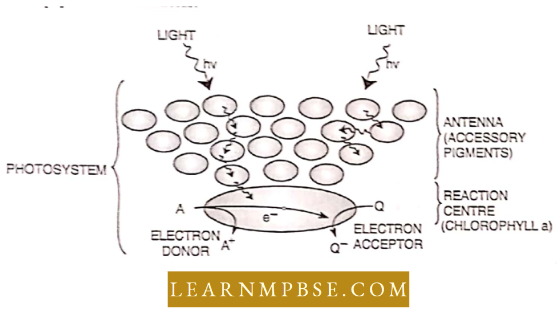
NEET Biology Photosynthesis And Translocation Of Organic Solutes Photophosphorylation Light phase
- Arnon et al (1954) discovered that isolated chloroplasts could synthesise ATP in the presence of light. Such a light-driven formation of ATP was called photophosphorylation.
- This is accompanied by photolysis of water, as a result of which O2 is released and H combines with N’.ADP to form NADPH. Photophosphorylation can be defined as the coupling of phosphate with ADP to produce ATP using light energy during photosynthesis.
- Cyclic photophosphorylation. When the photons activate Photosvstem I. a pair of electrons are raised to a higher energy level. They are captured by the primary acceptor which passes them on to ferredoxin (Fd), and plastoquinone (PQ). cytochrome complex, plasticity and (PC) and finally back to chlorophyll P7OQ.
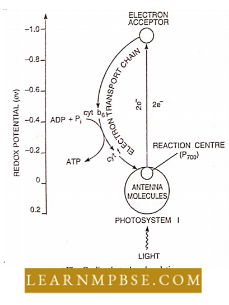
- The process is cyclic. At each step of electron transfer, the electrons lose potential energy. Their trip downhill is used by the transport chain to pump H+ across the thylakoid membrane. The proton gradient triggers ATP synthesis.
- Non-cyclic photophosphorylation. When both photosystems are illuminated, there is a continuous current of electrons flowing from water to NADP+. Electrons from P6g0 are replaced by electrons removed from water by splitting of water that evolves oxygen.

The excited electron from P680 flows down an electron transport chain to P700 (Pc- plastoquinone, cytochrome complex, PC-plastocyanin) generating ATP. Illumination of PSI boosts electrons to a high energy state which are passed to NADP reducing it to NADPH (protons from H2O. The net products of non-cyclic electron flow are ATP and NADPH.
NEET Biology Photosynthesis And Translocation Of Organic Solutes Calvin Cycle
Melvin Calvin (1954), an American scientist, worked out the path of carbon by using the paper chromatography technique. In recognition of his work, Calvin was awarded with Nobel Prize in 1961. Analysis of plant extracts was made within seconds after the beginning of photosynthesis with the injection of 14CO2.

Translocation Of Organic Solutes NEET
Various steps of the dark phase can be studied as under:
- Carboxylation. The first step is the carboxylation of Ribulose, 1,5 biphosphate (RuBP) by atmospheric CO2 in the presence of the enzyme RuBP carboxylase or rubisco.
- Six molecules of RuBP (5-carbon compound) come in contact with six molecules of CO2 to form six molecules of six carbon unstable compounds which are converted into 12 molecules of PGA (3-carbon compound) with the help of an enzyme called carboxydisniutase.
- Rubisco is a large protein molecule and constitutes 16 per cent of chloroplast protein and is one of the most abundant proteins on the earth.
- Glycolytic reversal. The 6 molecules of PGA utilise 6 ATP molecules to form 6 molecules of 1,3- diphosphoglyceric acid. These, in turn, utilize 6 NADPH supplied by the light reactions and get converted to a 3-C glyceraldehyde phosphate- a triose phosphate (TP).
- It seems to be a reversal of glycolysis, the only difference being that the reducing power is obtained from NADPH, and not NADP.
- PGA + ATP + NADPH -» Glyceraldehyde.
phosphate + NADP+ + ADP + IP - Regeneration of RuBP- F-6-P next undergoes a transketola.se relation that removes, the two top carbons as the thiamine pyrophosphate (TPP) derivative,, of glycoaldehyde, leaving the tetrose erythrose 4-phosphate (E-4-P).
- The (E-4-P) condenses,s by aldolase reaction, with DHAP to form sedoheptulose diphosphate (SDP), and this is converted by a second^ energy-liberating step to sedoheptulose-7-phosphate (S-7-P) and Pi by a phosphatase reaction.
- As far as can be determined, the same phosphatase works on FDP and SDP. The S-7-P undergoes a transketolase reaction in which. the two top carbons are removed as TPP- glycolaldehyde leaving the pentose ribose-5 phosphate (Ru-5-P).
- This is converted to ribulose-5-phosphate (Ru-5-P) by phosphopento.se isomerase. The TPP-glycoaldehyde derived from F-6-P and F-7-P in the transketolase reaction is transferred to PGA forming xylulose-5-phosphate (Xu-5-P) which is converted to Ru-5-R hy n phosphopentose epimerase. The R-5-P is converted to Ru-5-P by an isomer.

NEET Biology Photosynthesis And Translocation Of Organic Solutes Factors Affecting Photosynthesis
se and is phosphorylated by phosphoribulokinase. ATP being the donor produces ribulose biphosphate (RuDP) and ADP ( a second “priming” reaction that prepares the pentose for carboxylation).
- Light Intensity. The compensation point is 25-100 ft candles in shade plants and 100- 400 ft candles in sun plants. The optimum light intensity is 10% of full sunlight for shade plants and 50-70% of full summer sunlight for C3 sun plants.
- In C4 plants saturation point is not reached even in full sunlight. At higher light intensity, there is a decrease in photosynthesis called solarisation. It can be due to photoinhibition (reduction in hydration)and photoxidation.
- Light Quality. Red light favours carbohydrate synthesis while blue light stimulates protein synthesis. Maximum photosynthesis occurs in the blue and red parts while minimum photosynthesis takes place in the green part of the spectrum.
- Red light is more efficient in photosynthesis as compared to blue light. However, maximum photosynthesis occurs in full sunlight.
- Oxygen. In C3 plants, the optimum oxygen for photosynthesis is 2-5%. It is reduced at normal atmospheric concentration of oxygen. No such effect is found in C4 plants. Above 21% there is a reduction in photosynthesis (Warburg Effect).
- Chlorophyll. It is essential for photosynthesis. Photosynthesis does not occur in chlorotic regions. Willstatter and Stoll coined the term assimilation number or photosynthetic number as the number of CO2 molecules reduced per unit of chlorophyll. However, chlorophyll is always supra-optimal.
- Age. The rate of photosynthesis is maximum in just matured leaves but declines with age.
- If the rate of translocation becomes slower than the rate of synthesis, the latter also declines due to the accumulation of end products. Chemicals like cyanides, NH–, OH, CO, H2S, iodoacetates, chloroform, ethers, DCMU, CMU etc. inhibit photosynthesis.
- Accumulation of End Products. Accumulation of food in the chloroplasts reduces the rate of photosynthesis.
- Duration. Photosynthesis can continue indefinitely in the presence of light though the rate begins to fall slightly after 3-4 days of continuous exposure.
NEET Biology Photosynthesis And Translocation Of Organic Solutes Photorespiration
Respiration that is initiated in chloroplast and occurs in light is called photorespiration.
With an increase in temperature as on a hot summer day the affinity of RuBP carboxylase for CO2 decreases and O2 increases.
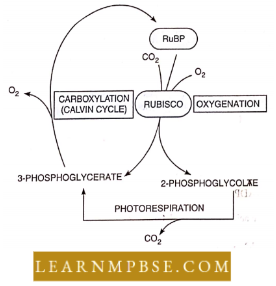
- As a result, RuBP is changed to 2 Phosphoglycolate and PGA. Thus photosynthetically fixed carbon is lost by photorespiration.
- Photorespiration takes place through the Involvement of three cell organelles, the chloroplast, peroxisomes and mitochondria.
- Photorespiration is the process of the uptake of O2 and the production of CO2 in light by photosynthesising tissues. It is quite common in C3 plants.
- Photorespiration causes a high loss of fixed carbon without producing energy-rich compounds is produced during this process.
- Photorespiration is also called a cycle because of 2-carbon intermediates.
- Linking Of Photorespiration To Calvin Cycle
- The first oxidative slop is the conversion of Rnl)P into 3-carbo PGA and 2-Carlion phosphor glycolic acid which moves lo peroxisomes to form glyoxylic acid, and the glyoxylic acid is converted to serine. Serine passes out to the mitochondria is converted into IHIA and finally enters the Calvin cycle.
NEET Biology Photosynthesis And Translocation Of Organic Solutes C4 Pathway
In plants like maize, sorghum, sugarcane etc. the CO2 molecule combines with IMiP to form a four-carbon compound, oxaloacetic acid (OAA). It is known as the C2 cycle because the initial product of CO2 fixation is a 4-carbon compound.
Overall C4 equation is
6PEP+ 6RuBP + 6CO2 + 30ATP + 12NAPH-> 6PEP + 6RuBP + C6 H2 O6 + 30ADP +30 H3 PQ4 + 12NADP

Difference Between C3 And C4 Plants
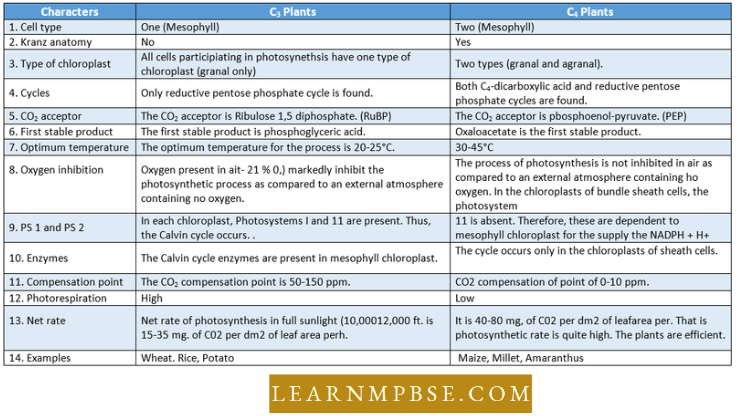
NEET Biology Photosynthesis And Translocation Of Organic Solutes Important Terms
- Calvin Cycle. The reductive pentose pathway of photosynthesis is named after its discoverer. It is also called a pathway”.
- Hill Reaction. It is the name of a part of the light reaction of photosynthesis, after R. Hill, who first observed it in 1937, Under Hill’s reaction, NADP is reduced to NADPH2
- Blackman’s law of limiting factors. It suggested that when a process is conditioned to its rapidity by it number of factors, keeping other factors constant, the rate of process is determined by the slowest or limiting factor.
- Reductive I’cntose Pathway. It is a set of reactions in the process of photosynthesis in which CO2 is fixed by ribulose-diphosphate ( a pentose sugar) to give PGA, which is used to produce a hexose sugar and more ribulose-diphosphate, which is used for further CO2 fixation.
- Sedohcpliilo.se. A seven-carbon compound formed in the Calvin cycle.
- C3 Pathway. It is another name for the Colvin cycle which is also called the reductive pentose pathway.
- C4 Pathway. It is a kind of CO2 fixation, found in some tropical plants-both monocotyledons and dicotyledons. It is also called the Hatch and Slack cycle.
- In this pathway, CO2 is fixed by a three-carbon compound (phosphoenol pyruvate) and ultimately a molecule with 4 carbon atoms (male) is produced.
- Plants, in which the C4 pathway is found, are called C4 plants, For Example. Saccharum, Sorghum, Maize, Cyperus etc.
- Photorespiration is absent in C4 plants. These plants use CO2 more efficiently than C3 plants.
- Crassulacean Acid Metabolism (CAM). It is a kind of CO2 fixation found in many succulent plants, For Example. Crassulaceae.
- Phosphoglyceric Acid (PGA). It is a compound with three atoms of carbon. It is the first product of the reaction between CO2 and ribulose diphosphate in the reductive pentose pathway of the process of photosynthesis.
- Ribulose diphosphate. A compound made up of a molecule of the pentose sugar ribulose and two phosphate groups. It is also called ribulose 1,5-diphosphate or RuDP. It is the main compound involved in CO2 fixation.
- Red drop. Sharp fall in the rate of photosynthesis as found by Emerson near the far end of the spectrum, This decline in photosynthesis is called the red drop.
- Spectrophotometer. An instrument used to measure the rate of absorption of different wavelengths of light by different pigments. The absorption of different wavelengths of light by a particular pigment is plotted and called the absorption spectrum.
NEET Biology Photosynthesis And Translocation Of Organic Solutes
- The food is translocated from the supply end or source (leaves) to the consumption end or sink (storage regions).
- The translocation of organic solutes takes place in plants in all directions.
- Downward translocation (from leaf to stem and roots)
- Upward translocation (from leaves to developing buds)
- Radial translocation (from the pith to the cortex).
- There is ample evidence to believe that food is translocated through phloem such as
its component structure, the effect of blocking phloem and ringing experiments conducted by Malpighin Stephan Hales and Curtis. - The experimental evidence collected by Rabadieu and Burr by using C14 and experiments-with aphids performed by Kennedy and Mittler also confirms phloem translocation of food. Some days may be translocated in an upward direction through the xylem.
- Radioactive isotopes such as P32, S35, Sr90, N15, C14, C11 and H3 have been used in recent years along with techniques like a reverse flap, autoradiography and freeze-drying.
- Food is translocated mainly as sucrose but also in the form of raffinose, stachyose, verbascose, mannitol, myoinositol and sorbitol.
- The rate of metabolite movement is calculated in terms of mass transfer rate. The translocation velocity may be 55 cm/hr (sucrose). It is 270 cm/hr in sugarcane and 290 cm/ hr in squash.
- Mechanism of Translocation. Several hypotheses have been proposed to explain the mechanism of translocation.
- It was earlier believed that good is translocated from source to sink by simple diffusion. Since the rate of diffusion is extremely slow hence Mason and Phillips proposed an activated diflusion hypothesis which lacked experimental evidence.
- De Vries proposed that food is translocated by streaming currents of protoplasm.
- It explains the bidirectional movement of metabolites and the faster rate of translocation. observe the streaming of protoplasm in mature sieve elements.
- Thaine and Canny observed streaming in vertically running transcellular strands in sieve elements. The presence of these strands has been confirmed by the use of C2 But the die rate of translocation as last as 290 cm/hr cannot be achieved by protoplasmic streaming.
- The activated diffusion theory of Mason and Maskell (1936) takes into account the utilization of ATP.
- Electro-osmotic theory was proposed by Fensom (1957) and Spanner (1958). According to this, an electropotential across the sieve plate is responsible for a faster rate of liquid flow.
- Munch’s Mass Flow or Pressure Flow Hypothesis (1930) Munch’s hypothesis postulated the movement of protoplasm mass along a turgor pressure gradient induced by the maintained gradient of water potential.
- This is based on the principle that an increase in turgor pressure causes mass flow’ of solution from production chamber A (comparable to leaf) to consumption chamber (comparable to root).
- The movement of solute will continue till the solutions in both chambers attain the same concentration.
- In living plants, the carbohydrates are continuously synthesized in mesophyll cells and are translocated to roots or storage organs through phloem.
NEET Biology Photosynthesis And Translocation Of Organic Solutes Factors Affecting Translocation
The process of food translocation is influenced by several factors as follows :
- Temperature: The effect of temperature may be direct or indirect. It has been experimentally confirmed that the optimum temperature for translocation ranges between 20 -30 C. It increases with the increase of temperature up to a maximum limit and then decreases.
- By using C14 it has been observed that the translocation rate increases in sugarcane when temperature is raised from 20 to 33 C. It has been also observed that when the root temperature is higher than the shoot, translocation to the root increases but to the shoot tip, decreases.
- If the condition is reversed i.e. when the shoot temperature is higher than the roots, translocation to the shoot tip increases and to the roots decreases.
- Light: The rate of translocation is influenced by light intensity. With the increase in light intensity the translocation to root as compared to shoot increases. However, by using C* it has been observed that in the dark, more food is translocated in the root of Glycine than in light.
- Minerals: It has been demonstrated that boron enhances the translocation of labelled sucrose in tomatoes. It is thought that boron makes a complex with sucrose. This borate sugar moves more rapidly than non-borate sugar. Phosphorus deficiency also reduces the translocation rate.
- Hormones: It is well known that cytokinins influence the translocation of soluble nitrogen
- compounds. When they have sprayed the leaves externally, translocation of N–, t compounds from lamina to petiole is retarded,’ hence it remains green for a longer period.
- Inhibitors: The metabolic inhibitors like azides, CP, 2-4 dinitrophenol (DNP), fluorides, HCN, iodoacetates etc. retard metabolism and thus indirectly influence the translocation process.
Photosynthesis is the single most important biological process required for human existence.
- Jan Baptism Van Uelmont (Belgian physician) with his simple experiments concluded that all the substance of plant was produced from water and none from soil Contribution of Jan Ingcnhonsz. He confirmed Priestley’s work and also discovered that the release of O, by plants was possible only in sunlight by green plants.
- Contribution of C.B. Van Nicl. He gave a simplified equation of photosynthesis.
- Contribution of Joseph Priestley (1703-1804). He showed that plants can take up CO2 from the atmosphere and release O2
- Within the leaf, photosynthesis occurs in specialised cells called mesophyll cells.
- PAR is photosynthetically active radiation of visible speed
- ATP, NADPH + H+ are produced in light reaction and are used for the reduction of CO2 Isolated chloroplast cannot carry out CO2 reduction because enzymes necessary for CO2 reduction are leached out during the isolation of chloroplasts.
- Chlorophyll acts as a reaction centre and accessory pigments called carotenoids act as antenna complexes and harvest light from different regions of the spectrum.

Photosynthesis And Translocation In Plants NEET
Crassulaccan Acid Metabolism (Cam Plants)
CAM plants fix CO2 at night, from malice which is stored in large vacuoles in mesophyll cells until the next day. CAM plants use the enzyme Pepco (PEP carboxylase). The malate formed at night releases CO2 during the day to the Calvin cycle within the same cell, which now has NADPH and ATP available from light-dependent reactions.
- CAM represents Crassulacean acid metabolism. The Crassulaceae is a family of flowering succulents. In CAM plants stomata open during night only and is an adaptation of xerophytic succulents. Photosynthesis in such cases is usually not as efficient as in C3 or C4 plants, but it allows the CAM plants to live under stress-
- Isolated chloroplasts can carry out CO2 reduction provided the leached substances are externally supplied to them.
- This was proved by D.I. Arnon and his associates.
- Dark reactions can occur in light as well as in the dark.
- The temperature coefficient (Q10) is defined as the ratio of the velocity of a reaction, at a particular temperature to that at a temperature 10°C lower.
- For a physical process, the value of Q10 is slightly greater than one.
- For photochemical reactions, the value of Q10 is one.
- For a chemical reaction, the value of Q10 is two or more i.e., with the rise of 10°C temperature, the rate of chemical reaction is doubled.
- The difference between C4 plants and CAM plants is that in C4 plants two cycles are separated by different leaf cells (i.e. in mesophyll cells and bundle sheath cells) whereas in CAM plants both pathways are found in mesophyll cells both being separated by time.
NEET Biology Photosynthesis And Translocation Of Organic Solutes Quanta to Memory
Chi C—C35 H32 O5 N4 Mg (Mol. wt.) = 712. Phytol absent it is present in brown algae + diatoms.
Chl d—C54 H70 O6_ N4 Mg (Mol. wt. 895) red algae
Bacteriochlorophyll a—C55 H74 O6 N4 Mg (Mol. wt. 911)
- Chi a : Chi b = 2.5-3.5 : 1
For sun plant 5.5: 1 [For heliophyte)
For shade plant 1:4:1 [For sciophyte] - Chlorophyll absorbs more of blue light than red light. 40% (Blue) 30% (Red) For Chi a 48% (Blue) 20% (Red) —For Chi b
- Bacteriochlorophyll-b found in Rhodopseudomonas is not yet known.
- Chlorobium Chlorophyll-old name of bacterioviridin
- Carotenoid-lipochrome. Fat-soluble, light not necessary.
- Calvin gave a molecular model of the chloroplast.
- Discovered by Wakineroder as a provitamin of carrot types – a, b, g and carotene, phytotene, neurosphere.
Ratio of xanthophyll: Carotene in plant 2:1.
- Xanthophyll Zeaxanthin gives a yellow colour to the leaf.
- Size of chlorophyll 15 A ‘ 15 A Porphyrin head while Phytol tail is 20 A long
- Chlorophyll absorbs light of wavelength 400-500 nm and 600-700 nm.
- During peak hour, the rate of photosynthesis is 20 times of respiration.
- C4 plants-Dimorphism grain mesophyll, e.g. sugarcane.
- Temp, range for algae; 75 C.
- C3 plant; 10-25°C, C4 plant-; 30°C-45°C.
- Solute translocated contains mostly 10-26% carbohydrates sucrose and 10% nitrogen compound.
- If CO2 increases by 15-20 times then photosynthesis increases if no other factor is limiting.
- If the CO2 cone decreases by 10-15 times, the rate of Photosynthesis decreases.
- The total amount of solar energy trapped by photoautotrophs is 0.024 % and the product, of photosynthesis, is 170 billion tonnes from 8 “108-metre tonne of carbon
NADP is called TPN (Triphosphopyridine nucleotide called Co II.
- The excited state remains for 5×1 O’9 sec.
- Coupling factors are present on the thylakoid.
- Bacterial Photosynthesis-Green Sulphur (e.g. chlorobium), Purple sulphur (Eg. Chromatium, Purple non-Sulphur (Rhodo Sperellum)
- In cyclic photophosphorylation, e“ released by the reaction centre is accepted by the reaction centre.
- The process of photophosphorylation is the same as mitochondrial reaction is called Oxidative phosphorylation.
- All types of plastid processes are the same as they can transform a frame from one form to another.
- Ratusky effect Chi shows out burst of fluorescence during the first few moments of illumination.
- C3 and C4 plants may occur in different species but the same genus For Example- Euphorbia corollata, E. macula
- In grass allotropes, semialata in the C3 plant and C4 plant occur in another ecotype.
- Photo-bioluminescence. The phenomenon of re-irradiation of absorbed energy. It consists of fluorescence which occurs almost instantaneously and phosphorencence occurs after a gap. Chlorophyll shows fluorescence. Their phosphorescence is doubtful.
- Carotenoids absorb light strongly in the blue-violet range. These are called shield pigments as they protect chlorophyll from photooxidation, (bleaching)
- Park and Biggins coined the term ‘Quantosomes’ for a group of pigment molecules required for carrying out a photochemical reaction. These occur in membranes of thylakoids. Each quantosome has 250-300 chlorophyll, carotenoids, quinone compounds, sulpholipids, phospholipids, protein and chlorophyll molecules-160 chi a, 70 chi b, 50 carotenoids.
- Chlorophyll transfers solar energy to reaction centres by resonance transfer or inductive resonance.
- Of the 90% of photosynthesis carried out by algae, 80% is carried out by marine and 10% by freshwater algae.
- Photosynthetic efficiency increases in intermittent light.
- The products of the light phase are not used immediately in the dark phase, so photosynthetic efficiency decreases in continuous saturating light.
- RuBP carboxylase or Rubisco is a large protein molecule and constitutes about 16% of chloroplast protein. It is the most abundant protein on the earth.
- O2 is a competitive inhibitor of CO2 fixation. Any increase in the O2 cone, would favour the uptake of O2 rather than CO2 and thus inhibit photosynthesis.
- Photorespiration is also called dark respiration and there is a loss of Carbon as CO, and a loss of energy in this process.
- Photorespiration reduces the potential yield of plants growing in the tropics by 30-40%.
- H.P. Kartschak and C.E. Hartt found that in sugarcane, a tropical plant, leaves removed CO, more efficiently from the atmosphere and the first products of photosynthesis were acids having 4-C atoms (Malic, OAA, aspartic acid) than 3 Carbon*acid PGA.
- The same has been found true for tropical plants including monocots (Maize, Sorghum and Eleusine) and dicots (Amaranthus and Euphorbia spp.)
- Chloroplasts in C4 plants are called dimorphic.
- Correlation between Kranz anatomy and C4 plants was established by Dewton and Treguna.
- 2.5-30° C is the optimum temperature for photosynthesis In opuntia it can be 55 C.
- In lichens -20° C to -24° C and in conifers -35° C.
- Total sugar in phloem sap can be up to 90%. Sucrose constitutes 5-15% of total sugars. Other sugars are raffinose (triose), stachyose (tetrose) and verbascose (pentose)
- Pure phloem saps may be collected by using sap-sucking aphids.
- Photosynthesis is an anabolic, endergonic, oxidation-reduction process.
- Solarisation-Destruction of chlorophyll due to high light intensity.
- The most common limiting factor for photosynthesis is CO,
- Compensation point- light intensity at which rate of photosynthesis = rate of respiration (In morning and evening)
- In C3, more CO is released in light than in dark (due to photorespiration)
- The yield of C3 plants is increased by increasing CO, in the atmosphere.
- Tracer Technique-Rabideau and Buer supplied C14 O2 to a leaf during photosynthesis. The sugar synthesised in this leaf was labelled with 14C (tracer). The presence of labelled sugars in the phloem showed that solutes are translocated through the phloem.
- Goodwin suggested that Chlorophyll and Carotenoids may be attached to the same protein forming a complex called photosynthin.
- Phycobilins are also known as biliproteins
- O2 of glucose comes from CO2 •
Out of total light, 1-2% light is used by green plants.
Enzyme PEP Carboxy dismutase in C4 plants is very sensitive to CO2, this is why C4 plants can absorb CO, from its low concentration while C3 plants fail to avail it from such a low concentration.
The first step of photosynthesis is the excitement of electrons of the chlorophyll molecule.
- The first chemical step of photosynthesis is the photolysis of H2
- The light reaction forms ATP or assimilatory power and NADPH2 which is used in the reduction of CO, in the dark phase.
- Light reaction occurs in the granum and dark reaction in the stroma.
- Phosphoglyceraldehyde-it is the connecting link between photosynthesis and respiration.
- During solarization, photooxidation occurs in which some cell constituents are oxidized.
- Light is never a limiting factor except on cloudy days.
- Photosynthesis occurs between 390-750 m.u.
- Assimilatory Number-It is the amount of CO2 absorbed in gms/hour by gm of chlorophyll.
- 48 light quantum is necessary for 6 CO2
- Bacteria photosynthesise at 900 mu wavelength
- Plastidome-Plastid complex of cell.
Quantum yield- No. of O2 released per photon or quantum of light. Its value is 1/8 —1/10. In other words, the evolution of one molecule of O2 or consumption of one molecule of CO2 requires 8-10 quanta.
NEET Biology Photosynthesis And Translocation Of Organic Solutes Questions From Competitive Examinations
Question 1. Which of the following occurs in the dark reaction of photosynthesis?
- Formation of ATP
- Release of O2
- Release of H,
- Synthesis of PGAL.
Answer: 4. Synthesis of PGAL.
Question 2. The first reaction in photosynthesis is :
- Photolysis of water
- Excitation of chlorophyll molecules
- Formation of ATP
- Fixation of CO2.
Answer: 2. Excitation of chlorophyll molecules
Question 3. Fixing one molecule of C02 in the Calvin cycle is required :
- 3 ATP + 1 NADPH
- 3 ATP + 2 NADPH2
- 2 ATP + 3 NADPH2
- 3 ATP + 3 NADPH
Answer: 2. 3 ATP + 2 NADPH2
Question 4. The enzyme required in early C02 fixation in the C4 cycle is :
- RuBP carboxylase
- RuBP oxygenase
- PEP carboxylase
- PGA dehydrogenase.
Answer: 2. RuBP oxygenase
Mechanism Of Phloem Transport NEET
Question 5. A chemical which absorbs light energy and changes it to chemical energy is :
- Xanthophyll
- Chlorophyll a
- Chlorophyll b
- Chlorophyll c.
Answer: 2. Chlorophyll a
Question 6. One of the following is a C4 plant:
- Sugarcane
- Tomato
- Mango
- Apple.
Answer: 1. Sugarcane
Question 7. Which pair is wrong?
- C3 – maize
- C4 – kranz anatomy
- Calvin cycle – PGA
- Hatch and Slack cycle
Answer: 1. C3 – maize
Question 8. Which pigment system is inactivated in the red drop :
- PS-1 and P.S-II
- PS-I
- PS-II
- None.
Answer: 3. PS-II
Question 9. Which plant is LDP :
- Tobacco
- Glycine max
- Mirabilis Jalapa
- Spinach.
Answer: 4. Spinach. Spinach.
Question 10. The proteinaceous pigment which controls the activities concerned with light is :
- Phytochrome
- Chlorophyll
- Anthocyanin
- Carotenoids.
Answer: 1. Phytochrome
Question 11. The first stable product of photosynthesis in C4 plants is :
- Ribulose a 5 – biphosphate
- Phosphoglyceric acid
- Malic acid
- PGAL.
Answer: 3. Malic acid
Question 12. Which one of the following is the aim of Moll’s half¬leaf experiment?
- To show that carbon dioxide is produced during aerobic respiration
- To show that carbon dioxide is produced during anaerobic respiration
- To show Chlorophyll is necessary for photosynthesis
- To show the importance of carbon dioxide for photosynthesis.
Answer: 4. To show the importance of carbon dioxide for photosynthesis
Question 13. Photosynthesis is maximum in :
- Blue light
- Greenlight
- Red light
- U.V. light.
Answer: 3. Red light
Question 14. Cyclic photophosphorylation form :
- ATP
- ATP and NADPH
- NADPH
- ATP, NADPH and O.
Answer: 1. ATP
Factors Affecting Photosynthesis NEET
Question 15. Which of the following possess both PS -1 and PS – II?
- Purple sulphur bacteria
- Green sulphur bacteria
- Cyanobacteria
- Purple non-sulphur bacteria.
Answer: 3. Cyanobacteria
Question 16. Evidence for liberation of 0, from water during photosynthesis comes from :
- Release of O80 if the water contains the same
- Isolated chloroplast supplied with reducing agents like potassium ferrocyanide evolves O2 even in
absence of CO2 - Photosynthetic bacteria do not liberate O2 and they use H, and S to obtain reduced power
- All the above.
Answer: 4. All the above.
Question 17. Which of the following provides energy to ETS by absorption of sunlight?
- Water
- Chlorophyll
- Mitochondria
- ATP.
Answer: 4. ATP.
Question 18. Photosystem II occurs in :
- The outer membrane of mitochondria
- Grana
- Stroma
- The inner membrane of mitochondria.
Answer: 2. Grana
Question 19. CO, acceptor in the C3 cycle is:
- PEG
- RuBP
- OAK
- Malic acid.
Answer: 2. RuBP
Question 20. ETS associated with photophosphorylation occurs in :
- Stroma
- Thylakoid
- The outer membrane of the chloroplast
- Mitochondria.
Answer: 4. Mitochondria.
Question 21. C4 plants are abundant in :
- Tropical regions with more dry conditions
- Tropical regions with more humid conditions
- Temperate region with more dry conditions
- Temperate regions with more humid conditions.
Answer: 2. Tropical region with more humid conditions
Question 22. Photorespiration in C, plants stall from :
- Phosphoglycerate
- Phosphoglycolate
- Glycerate
- Glycine.
Answer: 2. Phosphoglycolate
Question 23. Hill reaction occurs in :
- High altitude plant
- Total darkness
- Absence of water
- Presence of ferricyanide.
Answer: 4. Presence of ferricyanide
Question 24. In sugarcane plants 14CO2 is fixed in malic acid, in which the enzyme that fixes C02 is :
- Fructose phosphatase
- Ribulose biphosphate carboxylase
- Phosphoenol pyruvic acid carboxylase
- Ribulose phosphate kinase.
Answer: 3. phosphoenol pyruvic acid carboxylase
Question 25. Which of the following is not an electron carrier?
- CoQ
- Cytc
- Cyt a
- H2 O
- Cyt a3
Answer: 4. H2O
Question 26. How many molecules of glycine are required to release one molecule of CO2 during photorespiration?
- Four
- Three
- Two
- One.
Answer: 3. Two
Light Reaction And Dark Reaction NEET Notes
Question 27. Who demonstrated photolysis of water by isolated chloroplasts?
- Liebig
- M. Calvin
- Von Neil
- Hill.
Answer: 4. Hill.
Question 28. As compared to sun plants, plants adapted to low light intensity possess :
- Spiny leaves
- Extensive root system
- High rate of CO2 fixation
- Larger photosynthetic unit.
Answer: 4. Larger photosynthetic unit.
Question 29. In comparison to a C3 -plant, how many additional molecules of ATP are needed for the net production of one molecule of hexose sugar by C4 -plants :
- Six
- Two
- Zero
- Twelve.
Answer: 4. Twelve.
Question 30. Photosynthesis in C4 plants is relatively less limited by atmospheric C02 levels because
- Effective pumping of CO2 into bundle sheath cells
- The primary fixation of CO2 is mediated via PEP carboxylase
- Four carbon acids are the primary initial CO2 fixation products
- Rubisco in C4 plants has a higher affinity for CO2.
Answer: 2. The primary fixation of CO2 is mediated via PEP carboxylase
Question 31. Photosynthetic active radiation (PAR) has the following range of wavelengths :
- 400-700 nm
- 450-950 nm
- 340-450 nm
- 500-600 nm.
Answer: 1. 400-700 nm
Question 32. The pathway of the Calvin cycle was discovered by using an isotope of:
- 180
- 32P
- UC
- I4C.
Answer: 4. I4C.
Question 33. Chloroplast lacks :
- Carotene
- Chlorophyll
- Xanthophyll
- Anthocyanin.
Answer: 4. Anthocyanin.
Question 34. Bacterial photosynthesis does not show :
- Photosystem I
- Utilization of energy
- Evolution of oxygen
- Formation of organic product.
Answer: 4. Formation of organic product
Question 35. A phenomenon which converts light energy into chemical energy is:
- Respiration
- Photosynthesis
- Transpiration
- None of these.
Answer: 2. Photosynthesis
Question 36. In photosystem-I, the first electron acceptor is :
- Plastocyanin
- An iron-sulphur protein
- Cytochrome
- Ferredoxin.
Answer: 2. An iron-sulphur protein
Light Reaction And Dark Reaction NEET Notes
Question 37. The translocation of organic solutes in sieve tube members is supported by:
- Mass flow involving a carrier and ATP
- Cytoplasmic streaming
- Root pressure and transpiration pull
- P-proteins.
Answer: 4. P-proteins
Question 38. During photorespiration, the oxygen-consuming reaction (s) occur in :
- grana of chloroplasts and peroxisomes
- stroma of chloroplasts
- stroma of chloroplasts and mitochondria
- stroma of chloroplasts and peroxisomes.
Answer: 3. stroma of chloroplasts and mitochondria
Question 39. The Calvin cycle proceeds in three stages.
Reduction, during which carbohydrate is formed at the expense of the photochemically made ATP and NADPH
Regeneration, during which the carbon dioxide acceptor ribulose-1, 5-biphosphate is formed
Carboxylation, during which carbon dioxide combines with ribulose-1, 5-biphosphate.
Identify the correct sequence.
- 3-1-2
- 3-2 – 1
- l-2-3
- 2 – 1 – 3
- 1-3-2.
Answer: 1. 3-1-2
Question 40. Which of the following is a simplified equation of photosynthesis?
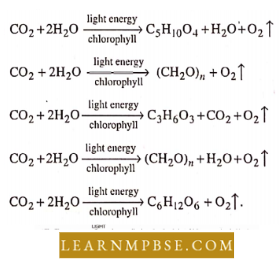
Answer: 4.
Question 41. Choose the correct combination of labelling the number of carbon compounds in the substrate molecules, involved in the citric acid cycle.
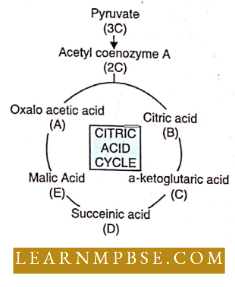
- A. 4C, B. 6C, C. 5C, D. 4C, E. 4C
- A. 6C, B. 5C, C. 4C, D. 3C, E. 2C
- A. 4C, B. 3C, C. 4C, D. 5C, E. 6C
- A. 4C, B. 5C, C. 6C, D. 4C, E. 4C
- A. 4C, B. 6C, C.4C, D. 4C, E. 4C.
Answer: 1. A. 4C, B. 6C, C. 5C, D. 4C, E. 4C
Question 42. In the given chart of photophosphorylation, what does “a” represent?
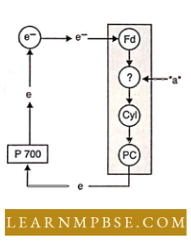
- PC
- FRS
- PQ
- Cyt. a3.
Answer: 3. PQ
Question 43. The reaction that is responsible for the primary fixation of CO2 is catalysed by:
- RuBP carboxylase
- PEP Carboxylase
- RuBP carboxylase and PEP
- PGA synthetase
Answer: 3. RuBP carboxylase and PEP
Question 44. The enzyme that is not found in the C3 plant is :
- RuBP carboxylase
- NAJDP reductase
- ATP synthase
- PEP carboxylase
Answer: 4. PEP carboxylase
Photosynthesis And ATP Production NEET
Question 45. Which of the following three organelles are involved in photorespiration?
- Chloroplast, mitochondrion, glyoxysome
- Chloroplast, peroxisome, mitochondrion
- Chloroplast, glyoxysome, mitochondrion.
- Chloroplast, lysosome, peroxisome
Answer: 2. Chloroplast, peroxisome, mitochondrion
Question 46. Consider the following statements :
A. The portion of the spectrum between 500 nm and 800 nm is also referred to as photosynthetically active radiation (PAR)
B. Magnesium, calcium and chloride ions play prominent roles in the photolysis of water
C. In cyclic photophosphorylation. oxygen is not released (as there is no photolysis of water) and NADPH is also not produced.
D. Of these statements given above
- A is true, but B and C are false
- A and B are false, but C is true
- B is true, but A and C are false
- A and B are true, but C is false
- A and C are true, but B is false
Answer: 2. A and B are false; but C is true
Question 47. Which of the following statements about photosynthesis is/are correct?
A. In C4 plants, the primary CO2 acceptor is PEP
B. In the photosynthetic process PS II absorbs energy at or just below 680 nm
C. The pigment that is present in the pigment system 1 is P683 :
- B and C only
- An only
- C only
- A and B only
- A and C only.
Answer: 4. A and C only.
Question 48. Consider the following statements regarding photosynthesis :
A. ATP formation during photosynthesis is termed as photophosphorylation
B. Kranz’s anatomy pertains to leaf
C. Reduction of NADP+ to NADPH occurs during the Calvin cycle
D. In a chlorophyll molecule magnesium is present in phytol til. Of the above statements :
- A and B are correct
- C and D are correct
- A and C are correct
- A and D are correct
- B and C are correct.
Answer: 1. A and B are correct
Question. 49. Which of the following statements is/are not true?
A. In CAM plants stomata open during the dark and remain closed during the day
B. Role of Na+ in stomatal opening is now universally accepted
C. The water of root cells is higher than the water potential of soil
D. Capillarity theory is the most accepted theory of water movement through plants
E. The walls of xylem vessels made up of lignocellulose have a strong affinity for water molecules
- B, C and E only
- B, C and D only
- A, B and C only
- B, and only
- A and E only.
Answer: 2. B, C and D only
Question 50. Which of the following is photophosphorylation?
- production of ATP from ADP
- production of NADP
- synthesis of ADP from ATP
- production of PGA.
Answer: 1. production of ATP from ADP
Question 51. In leaves of C4 plants, malic acid synthesis during CO, fixation occurs in the:
- bundle sheath
- guard cells
- epidermal cells
- mesophyll calls.
Answer: 4. mesophyll calls.
Question 52. Electrons from exited chlorophyll molecule of photosystem II are accepted first by :
- quinone
- ferredoxin
- cytochrome -b
- cytochrome -i
Answer: 1. quinone
Question 53. The C4 plants are photosynthetically more efficient than C3 plants because:
- the CO, efflux is not prevented
- they have more chloroplasts
- the CO, compensation point is more
- CO, generated during photorespiration is trapped and recycled through PEP carboxylase.
Answer : 3. the CO, compensation point is more
Question 54. CAM helps the plants in :
- Conserving water
- Secondary growth
- Disease resistance
- Reproduction.
Answer: 1. Conserving water
Question 55. A process that makes an important difference between C3 and C4 plants is :
- Glycolysis
- Photosynthesis
- Photorespiration
- Transpiration.
Answer : 3. Photorespiration
Photosynthesis And ATP Production NEET
Question 56. Which of the following concerning early experiments of photosynthesis is wrongly matched?
- (A) Joseph Priestley – Showed that plants release
- Jan Ingenhousz – Showed that sunlight is essential for photosynthesis
- Julius von Sachs – Proved that plants produce glucose when they grow
- T.W. Engelmann – Showed that the green substance is located within special bodies in plants
- Cornelius van Niel – Showed that hydrogen reduces CO, to carbohydrates.
Answer: 5. Cornelius van Niel – Showed that hydrogen reduces CO, to carbohydrates
Question 57. Which of the following statements regarding the C4 pathway is false?
- The primary CO, acceptor is phosphoenol pyruvate.
- The enzyme responsible for CO, fixation is PEPcase.
- The mesophyll cells lack RuBisCO enzyme.
- The C4 acid OAA is formed in the mesophyll cells.
- The bundle sheath cells contain the enzyme PEPcarboxylase.
Answer: 5. The bundle sheath cells contain the enzyme PEPcarboxylase
Question 58. Consider the following statements concerning photosynthesis.
A. The first carbon dioxide acceptor in the C4 cycle is PGA.
B. In C3 plants, the first stable product of photo-synthesis during dark reaction is RuBP.
C. Cyclic photophosphorylation results in the formation of ATP.
D. Oxygen which is liberated during photosynthesis comes from water. Of the above statements
- A and B alone are correct
- A and C alone are correct
- C and D alone are correct
- B and C alone are correct
- B and D alone are correct
Answer : 3. C and D alone are correct
Question 59. The diagram represents the Hatch and Slack pathways. Choose the correct combination of labelling numbered 1 to 5.
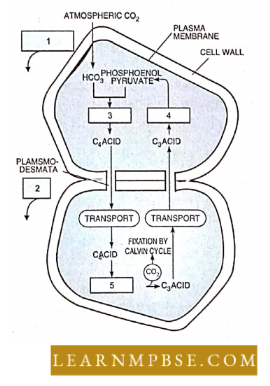
- 1-Mesophyll cell ; 2-Bundle sheath cell;
3-Regeneration; 4-Fixation; 5-Decarboxylation. - 1-Bundle sheath cell; 2-Mesophyll cell; 3-Fixation;
4- Regeneration; 5-Decarboxylation. - 1-Mesophyll cell; 2-Bundle sheath cell; 3-Decarboxylation; 4-Fixation; 5-Regeneration.
B1 The enzyme responsible for CO, fixation is PEPcase. - 1-Mesophyll cell; 2-Bundle sheath cell; 3- Fixation;
4-Decarboxylation; 5-Regeneration.
Answer: 4. 1-Mesophyll cell; 2-Bundle sheath cell; 3- Fixation; 4-Decarboxylation; 5-Regeneration.

